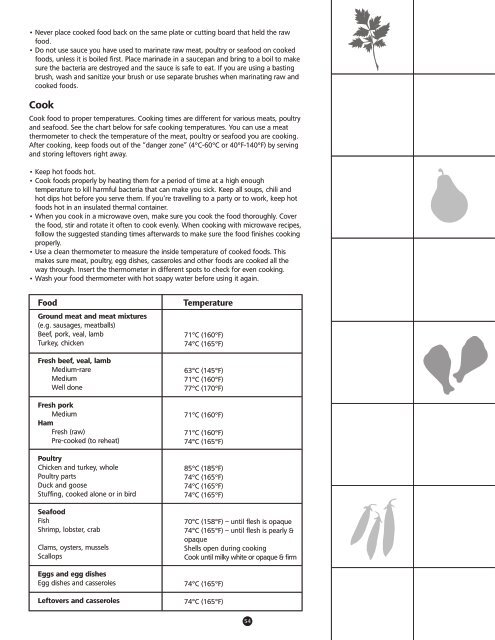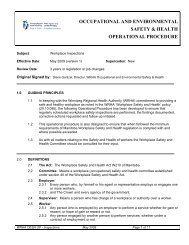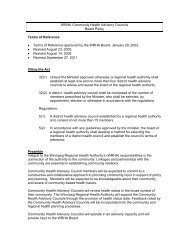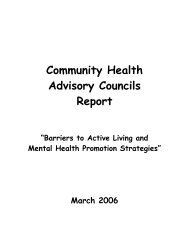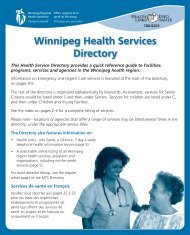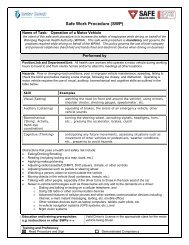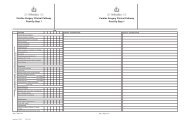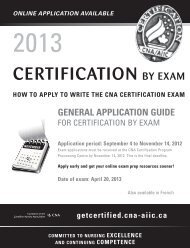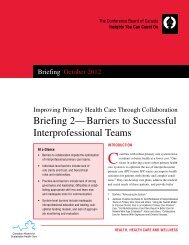Four Weeks of Healthy Menus - Winnipeg Regional Health Authority
Four Weeks of Healthy Menus - Winnipeg Regional Health Authority
Four Weeks of Healthy Menus - Winnipeg Regional Health Authority
You also want an ePaper? Increase the reach of your titles
YUMPU automatically turns print PDFs into web optimized ePapers that Google loves.
• Never place cooked food back on the same plate or cutting board that held the rawfood.• Do not use sauce you have used to marinate raw meat, poultry or seafood on cookedfoods, unless it is boiled first. Place marinade in a saucepan and bring to a boil to makesure the bacteria are destroyed and the sauce is safe to eat. If you are using a bastingbrush, wash and sanitize your brush or use separate brushes when marinating raw andcooked foods.CookCook food to proper temperatures. Cooking times are different for various meats, poultryand seafood. See the chart below for safe cooking temperatures. You can use a meatthermometer to check the temperature <strong>of</strong> the meat, poultry or seafood you are cooking.After cooking, keep foods out <strong>of</strong> the “danger zone” (4°C-60°C or 40°F-140°F) by servingand storing leftovers right away.• Keep hot foods hot.• Cook foods properly by heating them for a period <strong>of</strong> time at a high enoughtemperature to kill harmful bacteria that can make you sick. Keep all soups, chili andhot dips hot before you serve them. If you’re travelling to a party or to work, keep hotfoods hot in an insulated thermal container.• When you cook in a microwave oven, make sure you cook the food thoroughly. Coverthe food, stir and rotate it <strong>of</strong>ten to cook evenly. When cooking with microwave recipes,follow the suggested standing times afterwards to make sure the food finishes cookingproperly.• Use a clean thermometer to measure the inside temperature <strong>of</strong> cooked foods. Thismakes sure meat, poultry, egg dishes, casseroles and other foods are cooked all theway through. Insert the thermometer in different spots to check for even cooking.• Wash your food thermometer with hot soapy water before using it again.FoodGround meat and meat mixtures(e.g. sausages, meatballs)Beef, pork, veal, lambTurkey, chickenFresh beef, veal, lambMedium-rareMediumWell doneFresh porkMediumHamFresh (raw)Pre-cooked (to reheat)PoultryChicken and turkey, wholePoultry partsDuck and gooseStuffing, cooked alone or in birdSeafoodFishShrimp, lobster, crabClams, oysters, musselsScallopsEggs and egg dishesEgg dishes and casserolesLeftovers and casserolesTemperature71°C (160°F)74°C (165°F)63°C (145°F)71°C (160°F)77°C (170°F)71°C (160°F)71°C (160°F)74°C (165°F)85°C (185°F)74°C (165°F)74°C (165°F)74°C (165°F)70°C (158°F) – until flesh is opaque74°C (165°F) – until flesh is pearly &opaqueShells open during cookingCook until milky white or opaque & firm74°C (165°F)74°C (165°F)54


